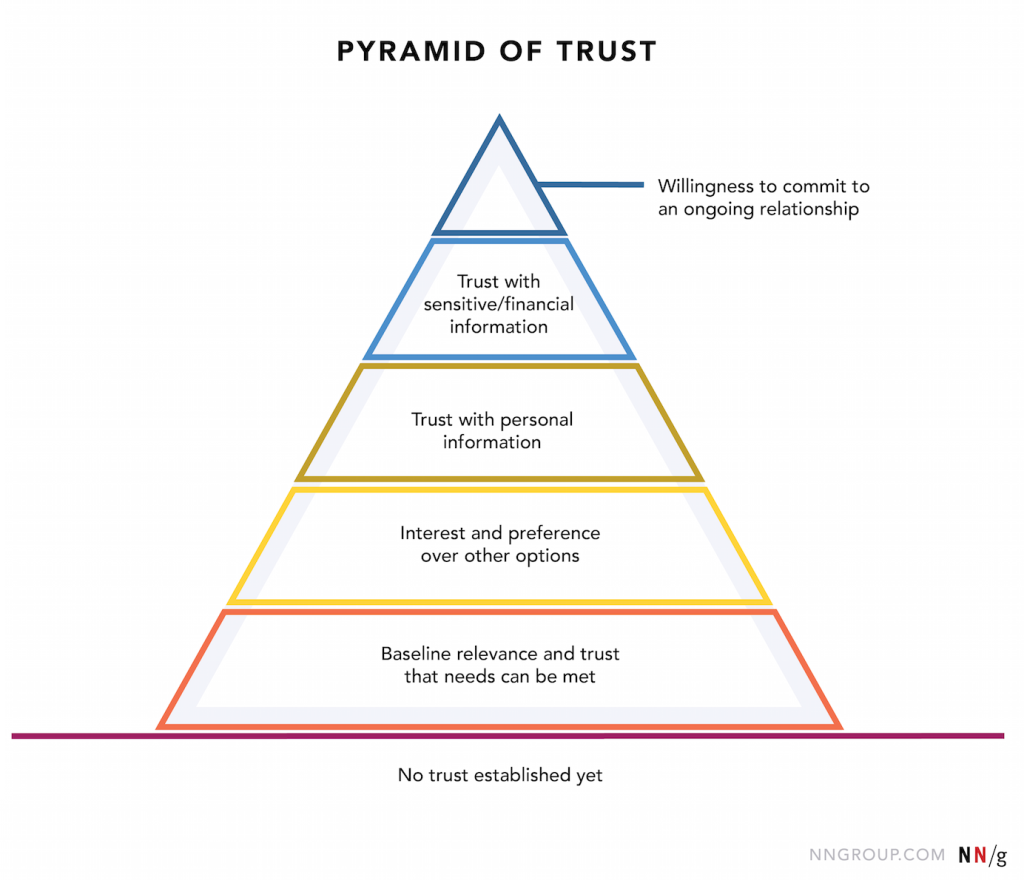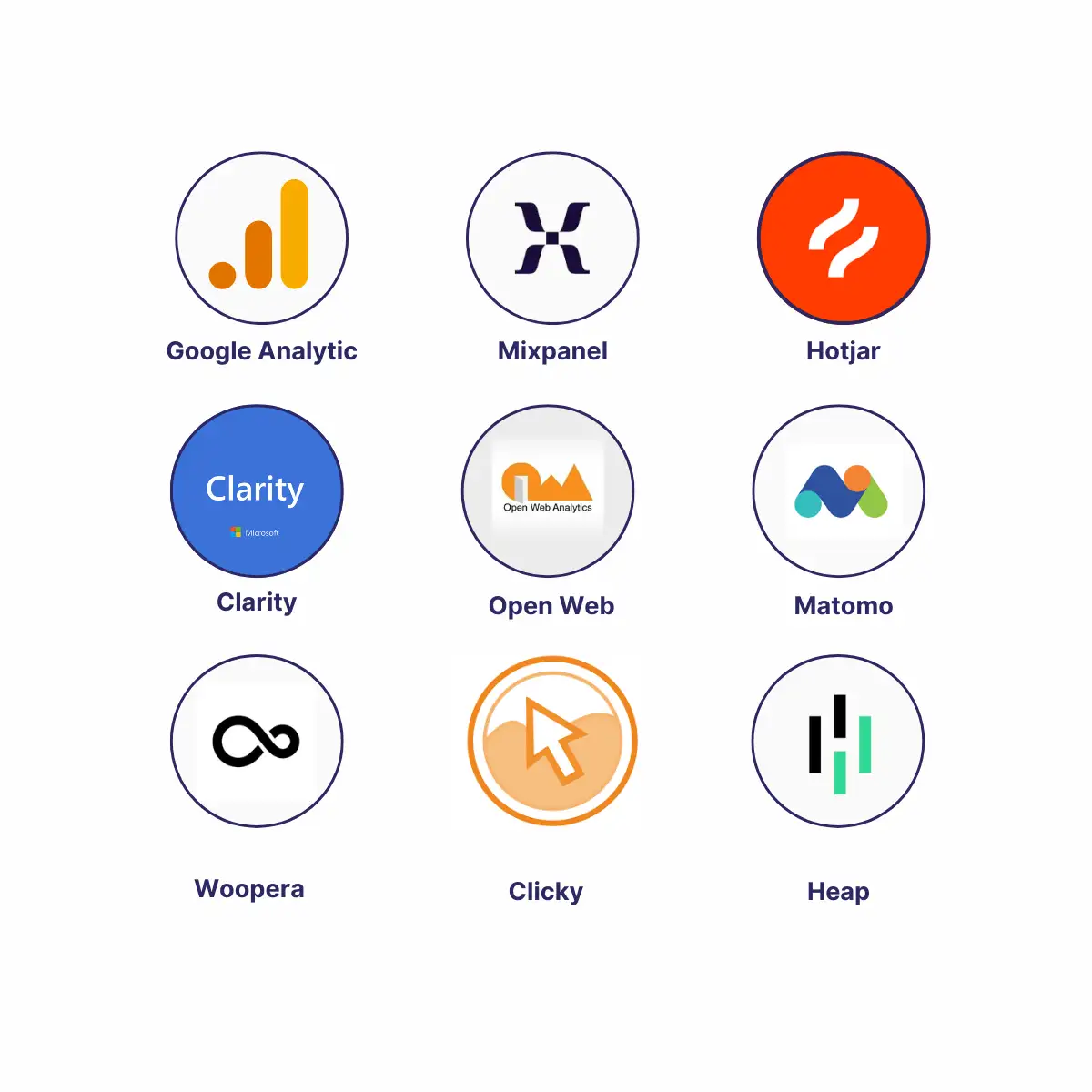Building trust is the ultimate marketing strategy, without trust, a business transaction is just a gamble.
Think about your own browsing and buying behaviors – how many times have you left a website because something didn’t seem right? When trust is lacking, we move on and search for brands that we feel comfortable with.
To keep brand loyalty, companies must stick to their stated principles. Millennial and Gen Z customers are particularly drawn to companies whose values align with their own, with over 91% of consumers preferring to switch brands.
In this article I will discuss 20 practical methods to help visitors trust your website.
The Pyramid of Trust
The Nielsen Norman Group (NNG) has made a trust pyramid based on Abraham Maslow’s hierarchy of needs. It shows the basic trust needs that must be met before a relationship can progress.
NNG explains that : “establishing trust, whether with a stranger or with a website, is gradual: as the relationship progresses, skepticism is overcome, the comfort level increases, and new demands can be made. The relationship evolves through different stages of commitment, each built on top of the previous ones.“
Different signs of trust become important at different stages of a buyers journey.

Image: NNGroup.com
the Hierarchy of Trust: Five Levels
According to NNG, website-visitor relationships go through five different levels of commitment. These levels start from the bottom and each higher level builds upon the lower ones. At each level, the visitor has different needs that need to be fulfilled.
| Level of Commitment | Users’ Trust Needs |
| 1. Baseline relevance and trust that needs can be met | Could this site help me accomplish my goal? Is it credible and can I depend on this information? Does it seem to have my best interests at heart? |
| 2. Interest and preference over other options | Do I choose to use this site for this task? Is it better than other options? |
| 3. Trust with personal information | Is this site’s offering valuable enough to justify the time and effort to register? Do I trust the site with my personal information? Do I want emails from this company? |
| 4. Trust with sensitive/financial information | Do I trust this site to securely use and store my sensitive data (e.g. credit card, street address)? Is it worth the risk? |
| 5. Willingness to commit to an ongoing relationship | Am I comfortable enough to establish a continuous connection with this site (e.g., recurring charge, linking with other accounts)? |
20 WAYS TO BUILD TRUST WITH YOUR WEBSITE VISITORS
Every organization, website, customer, and buyer’s journey is unique. So, the tips we provide may apply to different stages of trust for different people.
Some tips may be more relevant to the top levels of trust on certain websites, while others may be more relevant to the bottom levels.
However, this list is organized in a step-by-step manner and follows the pyramid-like structure. We will start by building a foundation of trust and then continue to strengthen that trust in order to develop a better relationship with website visitors.
Here are 20 strategies to gain trust on a website.
1. Ensure the Website is Secure
The first opportunity for a website to gain trust is through its URL. It doesn’t matter what the website’s content is, visitors will want to make sure the website is safe. Most website providers offer secure websites with Hyper Text Transfer Protocol Secure (HTTPS), but some still don’t meet this basic requirement.
You can tell if a website is secure by looking at the URL – it should start with HTTPS instead of HTTP. HTTPS uses SSL encryption to create a secure connection.
If your website is not HTTPS secure, you should consider switching over. About half of all websites are now encrypted with HTTPS, so it’s important to make this change.
You May Find Useful : Web Security 101 – Best Practices For Protecting Your Business
2. Use High-quality Images
Websites that use bad or generic stock images are not doing themselves any favors. It immediately makes the brand seem less reputable, and people start questioning the quality of the product or service.
On the other hand, using high-quality images is really simple to do on your website. There are plenty of free stock images and image editing programs that you can use, often without spending any money.
3. Use Clear Language: Avoid Slang and Jargon
Websites that focus on technical and scientific topics often have a problem. They use complicated and confusing words and phrases.
However, because we deal with complex subjects in our industry, it’s sometimes hard to avoid using complex language. But if a simpler word or sentence can convey the same meaning, it’s better to use it.
Remember, our industry is global, and even though websites can be translated into different languages, it’s important to keep things simple so that people from different continents can understand us.
To gain trust and avoid confusing jargon, it’s also best to avoid using casual language and speak professionally.
4. Consistency of brand and message
Consistency is a really important part of branded communications. When it comes to marketing your brand, you need to follow some guidelines that include how you talk, the kind of images you use, the colors you choose, and the main messages you want to get across.
It’s important to keep all of these things consistent on your website. If any of these things don’t match up, it can make your brand seem different and that’s something marketers want to avoid because trust is the goal.
So, make sure your website and content stick to your brand guidelines.
5. Promote testimonials and case studies
One of the most effective ways to earn trust, especially in business-to-business relationships, is to share content that showcases your current and previous customers.
This serves as evidence that you have successfully delivered on your promises regarding your products or services.
Review sites like Trustpilot and Google Reviews are also valuable for building trust. Once you receive positive reviews on these platforms, you can use them on your website as well.
6. Certifications and awards
Websites can gain trust by showing their industry partners, important certifications, and awards. Even if your organization has been mentioned on a trustworthy third-party website, you can still have chances to prove it.
Displaying logos that represent good practices or accomplishments can quickly build trust.
7. Own Your Weaknesses: Be Transparent
If you provide a product or service, it’s possible that your offering isn’t perfect and has some areas where it falls short.
A survey conducted by G2 and Heinze Marketing discovered that up to 40% of business-to-business buyers believe that negative reviews actually make a product more credible.
Being honest about your shortcomings shows integrity and helps to establish trust with the people who visit your website.
94% of customers are loyal to websites that are transparent.
If you think this approach goes against common sense, you can start by removing any exaggerated or overly sales-focused content from your website.
8. Educate rather than sell
Companies and online advertisers have noticed that people who visit websites are more interested in educational information than advertisements. Think of a website as a place where your target audience can go to learn about a specific topic.
By providing valuable resources, you can gain a lot of trust from your audience. This is where the inbound marketing approach comes into play.
Instead of forcing promotional content onto your visitors, focus on creating helpful and informative content that will attract them to your website.
9. Include your clients or your target audience in your content
Sometimes, published content may not be appropriate for the intended audience due to various reasons. In order for the content to truly connect with and gain the trust of the audience, it is very helpful to incorporate the target audience directly into the content.
This can be done by focusing the story on a character who resembles the target audience, making the website visitor feel more connected.
Alternatively, specific content can be created for a particular person or organization. This approach can gradually build trust with each individual visitor.
10. Provide additional business information
Provide some information about your organization on the “about” page without being too promotional. This page is valuable because it gives visitors a quick overview of your business values, how long you have been operating, who is involved in the organization, and how it functions.
Feel free to include any other details that you think will help build trust with visitors.
11. Personalization
Personalization is becoming more important for marketers. It has been shown to improve important goals for websites, like getting people more engaged and increasing the number of conversions.
Personalization helps with this because it builds trust between the visitor and the website.
When the content on a website is more relevant to the visitor, they are more likely to trust the website.
12. Make your team members known
Make sure to have a “meet the team” page, no matter how big or small your organization is. If your organization is large, include important and customer-facing individuals on that page.
Additionally, think about using pictures and contact information of your staff on important pages like the blog, services, and contact page to make it more familiar and welcoming.
13. Keep the design modern
Having a modern design makes a website look professional and gives it a sense of credibility, which can help build trust with visitors even before they start reading the content.
You May Find Useful : 7C’s Of Website Design: Tips For Businesses With Examples
14. Incorporate Social Media
Social media provides business professionals with an additional way to connect with people who have an interest in their company. It is often a more casual and relaxed way of communicating.
Social media can be very useful for building trust with stakeholders and is considered one of the most effective tools for this purpose.
Not only does it allow for direct support, but sharing content on social media can also help generate positive word-of-mouth publicity, creating valuable social proof for potential customers.
You May Find Useful : Facebook SEO: 11 Potential Ranking Factors For Higher Rankings
15. Keep the site up-to-date
Neglected news and blog pages, expired deals, and outdated business information indicate that the organization is either closed or close to shutting down.
Try to post a new piece of content every week, or at least once a month if you’re really busy, to demonstrate to visitors that there are actual people behind the website, not just for the sake of search engine benefits.
16. Remove broken links
Get rid of any broken links on your website by using a link checker. Also, make sure to set up redirects, so that you don’t waste your visitors’ time and risk losing their trust.
17. Limit the number of ads (or other distractions)
Websites should make sure they don’t have too many ads and avoid overwhelming the visitor with annoying content.
This will actually make it harder to gain the visitor’s trust. It’s important to limit the number of ads, whether they are your own or from another company.
18. Make it easy to get in touch
Many times, when people visit a website, they have questions about the information they find. This is especially true if the visitor is thinking about buying something or starting to consider a purchase.
Websites that provide easy ways to contact the organization, such as through phone or chat, appear trustworthy and willing to answer questions. They don’t seem to avoid or ignore inquiries.
19. Display other guarantees and disclosures
Especially in the world of e-commerce, where trust is paramount, hidden terms can really damage trust on websites. It’s important to be open and honest about all the information, including what you plan to do with other people’s information.
This is especially true when people sign up for newsletters and other emails. Also Clearly outline your refund policies.
20. Improve load time
One of the most crucial tips on this list is to make sure your website loads quickly. There are two reasons why this is important.
Firstly, if a website takes a long time to load, it can frustrate users and make them lose trust in your site.
Secondly, if your website is extremely slow, visitors may not even get to see the content you have worked hard to build trust with, as they will leave before it loads.
Test your website’s speed to make sure it doesn’t lose trust due to slow loading times.
In conclusion, nurturing trust with your website visitors is not only essential but achievable through strategic implementation of the 20 proven methods discussed. By prioritizing transparency, reliability, and user-centric experiences, you can forge lasting connections, foster loyalty, and elevate your online presence






